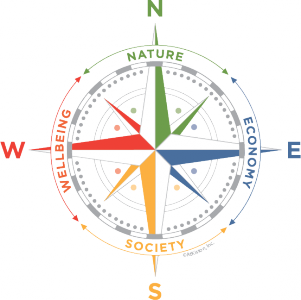
“When we try to pick out anything by itself, we find it hitched to everything else in the Universe.”
— John Muir
“Ultimately, as quantum physics showed so dramatically, there are not parts at all. What we call ‘a part’ is merely a pattern in an inseparable web of relationships.”
— Fritjof Capra
John Muir’s comment, written early in the 20th Century, was a poetic expression of a personal epiphany that came to him in nature, no doubt during one of his extended wilderness experiences. He felt in a deeply intuitive and spiritual way that everything is connected.
Muir knew nothing of quantum physics, which was just beginning to evolve as he wrote this famous line. He had no idea that science would prove the literal truth of his profound personal insight. Physicist Fritjof Capra’s statement may not be as poetic, but it is just as profound… and perhaps a little unsettling.
Sustainability is like that: profound, and a little unsettling. And, like Muir and Capra, sustainability makes a big deal about the interconnectedness of all things.
It’s very challenging to describe such heady stuff in an elevator speech. Sustainability is complex. It requires considering “facts” and observations in the context of interconnected parts and dynamic interdependent systems that, without careful investigation, are hard to see and are often counter-intuitive. Sustainability requires that we venture deep below the surface of thought. In many ways it’s just common sense. At the same time it represents a significantly different worldview, a fundamental shift in the way we think about and see the world.
Several frameworks have been developed to more simply explain sustainability. They are all useful, and all have their limitations: The Triple Bottom Line, The Natural Step, economist Herman Daly’s Triangle of Means and Ends are just a few. A useful framework we have settled on to capture the interconnected, whole-system concept is the Compass of Sustainability, pictured above.
The Compass was actually inspired by Daly’s triangle, and came as a spark of inspiration to our friend and sustainability colleague, Alan AtKisson. He describes the moment of creation in his book The Sustainability Transformation.
What we like about the Compass is that it illustrates how environment, economy, society, and personal wellbeing are all aspects of sustainability. Like a prism, it distinguishes the “parts” of sustainability, parts that are in fact interwoven “pattern(s) in an inseparable web of relationships.” One interdependent whole.
Sustainability exists to ensure that the future we create is one that provides wellbeing for everyone. Sustainability’s focus is people and society, and each point of the Sustainability Compass represents one essential system condition for a flourishing, abundant world for people and all species on earth, with whom we are intimately interconnected.
Here are the four system conditions required to fulfill the promise of sustainability, one for each point of the Sustainability Compass:
• Nature: humans individually and collectively understand and live in accord with the laws of Nature
• Economy: an Economy that is viable, prosperous, fair, and inclusive
• Society: communities that are characterized by civic vitality: diversity, connectedness, caring, justice, inclusiveness, and engagement
• Wellbeing: individual health, opportunity, fulfillment, happiness, and wellbeing are optimized.
What this means for all of us is that no matter where we are in life, no matter what we do for a living, no matter our perspective, we are all in positions to make a positive difference at many points around the Sustainability Compass. If Fritjof Capra, David Bohm, and other physicists and philosophers are right, we are connected with each other and all life on earth in ways we do not perceive or appreciate.
The implications for our influence, positive or negative, are enormous. As Jane Goodall says, the type of influence we have is up to us:
“What you do makes a difference, and you have to decide what kind of a difference you want to make.”
— Jane Goodall





Join the discussion One Comment